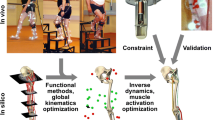Abstract
Knee forces directly affect arthroplasty component survivorship, wear of articular bearing surfaces, and integrity of the bone-implant interface. It is not known which activities generate forces within a range that is physiologically desirable but not high enough to jeopardize the survivorship of the prosthetic components. We implanted three patients with an instrumented tibial prosthesis and measured knee forces and moments in vivo during exercise and recreational activities. As expected, stationary bicycling generated low tibial forces, whereas jogging and tennis generated high peak forces. On the other hand, the golf swing generated unexpectedly high forces, especially in the leading knee. Exercise on the elliptical trainer generated lower forces than jogging but not lower than treadmill walking. These novel data allow for a more scientific approach to recommending activities after TKA. In addition, these data can be used to develop clinically relevant structural and tribologic testing, which may result in activity-specific knee designs such as a knee design more tolerant of golfing by optimizing the conflicting needs of increased rotational laxity and conformity.







Similar content being viewed by others
References
Biewener AA, Farley CT, Roberts TJ, Temaner M. Muscle mechanical advantage of human walking and running: implications for energy cost. J Appl Physiol. 2004;97:2266–2274.
D’Lima DD, Patil S, Steklov N, Chien S, Colwell C Jr. In vivo knee moments and shear after total knee arthroplasty. J Biomech. 2007;40:S11–S17.
D’Lima DD, Patil S, Steklov N, Slamin JE, Colwell CW Jr. The Chitranjan Ranawat Award: in vivo knee forces after total knee arthroplasty. Clin Orthop Relat Res. 2005;440:45–49.
D’Lima DD, Patil S, Steklov N, Slamin JE, Colwell CW Jr. Tibial forces measured in vivo after total knee arthroplasty. J Arthroplasty. 2006;21:255–262.
Diduch DR, Insall JN, Scott WN, Scuderi GR, Font-Rodriguez D. Total knee replacement in young, active patients. Long-term follow-up and functional outcome. J Bone Joint Surg Am. 1997;79:575–582.
Ellis MI, Seedhom BB, Wright V. Forces in the knee joint whilst rising from a seated position. J Biomed Eng. 1984;6:113–120.
Ericson MO, Nisell R. Tibiofemoral joint forces during ergometer cycling. Am J Sports Med. 1986;14:285–290.
Glitsch U, Baumann W. The three-dimensional determination of internal loads in the lower extremity. J Biomech. 1997;30:1123–1131.
Harrison RN, Lees A, McCullagh PJ, Rowe WB. A bioengineering analysis of human muscle and joint forces in the lower limbs during running. J Sports Sci. 1986;4:201–218.
Healy WL, Iorio R, Lemos MJ. Athletic activity after joint replacement. Am J Sports Med. 2001;29:377–388.
Jones DL, Cauley JA, Kriska AM, Wisniewski SR, Irrgang JJ, Heck DA, Kwoh CK, Crossett LS. Physical activity and risk of revision total knee arthroplasty in individuals with knee osteoarthritis: a matched case-control study. J Rheumatol. 2004;31:1384–1390.
Kaufman KR, Kovacevic N, Irby SE, Colwell CW. Instrumented implant for measuring tibiofemoral forces. J Biomech. 1996;29:667–671.
Kirking B, Krevolin J, Townsend C, Colwell CW Jr, D’Lima DD. A multiaxial force-sensing implantable tibial prosthesis. J Biomech. 2006;39:1744–1751.
Lavernia CJ, Sierra RJ, Hungerford DS, Krackow K. Activity level and wear in total knee arthroplasty: a study of autopsy retrieved specimens. J Arthroplasty. 2001;16:446–453.
Lu TW, O’Connor JJ, Taylor SJ, Walker PS. Validation of a lower limb model with in vivo femoral forces telemetered from two subjects. J Biomech. 1998;31:63–69.
Mallon WJ, Callaghan JJ. Total knee arthroplasty in active golfers. J Arthroplasty. 1993;8:299–306.
Mintz L, Tsao AK, McCrae CR, Stulberg SD, Wright T. The arthroscopic evaluation and characteristics of severe polyethylene wear in total knee arthroplasty. Clin Orthop Relat Res. 1991;273:215–222.
Mont MA, Marker DR, Seyler TM, Gordon N, Hungerford DS, Jones LC. Knee arthroplasties have similar results in high- and low-activity patients. Clin Orthop Relat Res. 2007;460:165–173.
Mont MA, Rajadhyaksha AD, Marxen JL, Silberstein CE, Hungerford DS. Tennis after total knee arthroplasty. Am J Sports Med. 2002;30:163–166.
Morrison JB. The mechanics of the knee joint in relation to normal walking. J Biomech. 1970;3:51–61.
Redfield R, Hull ML. On the relation between joint moments and pedalling rates at constant power in bicycling. J Biomech. 1986;19:317–329.
Seireg A, Arvikar. The prediction of muscular lad sharing and joint forces in the lower extremities during walking. J Biomech. 1975;8:89–102.
Singerman R, Berilla J, Archdeacon M, Peyser A. In vitro forces in the normal and cruciate-deficient knee during simulated squatting motion. J Biomech Eng. 1999;121:234–242.
Taylor SJ, Walker PS. Forces and moments telemetered from two distal femoral replacements during various activities. J Biomech. 2001;34:839–848.
Taylor WR, Heller MO, Bergmann G, Duda GN. Tibio-femoral loading during human gait and stair climbing. J Orthop Res. 2004;22:625–632.
Acknowledgments
We thank Juan Hermida, MD, for his contribution to the in vitro testing of the implants, Zachary Dooley, MS, for assistance with data collection and analysis, and Judy Blake for manuscript formatting and copyediting.
Author information
Authors and Affiliations
Corresponding author
Additional information
Each author certifies that he or she has no commercial associations (eg, consultancies, stock ownership, equity interest, patent/licensing arrangements, etc) that might pose a conflict of interest in connection with the submitted article.
Each author certifies that his or her institution has approved the human protocol for this investigation, that all investigations were conducted in conformity with ethical principles of research, and that informed consent for participation in the study was obtained.
About this article
Cite this article
D’Lima, D.D., Steklov, N., Patil, S. et al. The Mark Coventry Award: In Vivo Knee Forces During Recreation and Exercise After Knee Arthroplasty. Clin Orthop Relat Res 466, 2605–2611 (2008). https://doi.org/10.1007/s11999-008-0345-x
Received:
Accepted:
Published:
Issue Date:
DOI: https://doi.org/10.1007/s11999-008-0345-x




